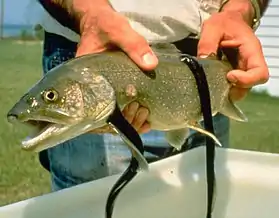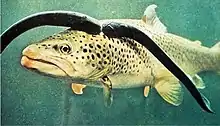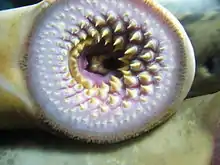Sea lamprey
The sea lamprey (Petromyzon marinus) is a parasitic lamprey native to the Northern Hemisphere. It is sometimes referred to as the "vampire fish."
| Sea lamprey | |
|---|---|
 | |
| Sea lampreys on a lake trout. | |
 | |
| Scientific classification | |
| Kingdom: | Animalia |
| Phylum: | Chordata |
| Class: | Hyperoartia |
| Order: | Petromyzontiformes |
| Family: | Petromyzontidae |
| Genus: | Petromyzon Linnaeus, 1758 |
| Species: | P. marinus |
| Binomial name | |
| Petromyzon marinus | |
| Synonyms[2][3] | |
|
Genus synonymy
Species synonymy
| |
Description
The sea lamprey has an eel-like body without paired fins. Its mouth is jawless, round and sucker-like, and as wide or may be wider than the head; sharp teeth are arranged in many consecutive circular rows. There are 7 branchial or gill-like openings behind the eye. Sea lampreys are olive or brown-yellow on the dorsal and lateral part of the body, with some black marblings, with lighter coloration on the belly. Adults can reach a length of up to 120 cm (47 in) and a body weight up to 2.3 kg (5.1 lb).[4]
Distribution and habitat
The species is found in the northern and western Atlantic Ocean along the shores of Europe and North America, in the western Mediterranean Sea, the Black Sea, and in the shores of the Great Lakes.[1] They have been found at depths to 4000 m and tolerate temperatures of 1–20 °C (34–68 °F).[4] They are native to the Connecticut River basin in the United States.[5]
The largest European populations of sea lampreys are located throughout the southwestern areas of Europe (north-central Portugal, north-northwest of Spain, and west–southwest of France).[6] These countries also support the main fisheries of the species.[7]
Ecology
Sea lampreys are anadromous; from their lake or sea habitats, they migrate up rivers to spawn. Females deposit a large number of eggs in nests made by males in the substrate of streams with moderately strong current. Spawning is followed by the death of the adults. Larvae burrow in the sand and silt bottom in quiet water downstream from spawning areas and filter-feed on plankton and detritus.[1]
After several years in freshwater habitats, the larvae undergo a metamorphosis that allows young, post-metamorphic lampreys to migrate to the sea or lakes, and start the adult hematophagous method of feeding.[8] Some individuals start hematophagous feeding in the river before migrating to the sea,[9] where sea lampreys prey on a wide variety of fish.[10]
The lamprey uses its suction cup-like mouth to attach itself to the skin of a fish and rasps away tissue with its sharp, probing tongue and keratinized teeth. A fluid produced in the lamprey's mouth, called lamphredin,[11] prevents the victim's blood from clotting. Victims typically die from excessive blood loss or infection. After one year of hematophagous feeding, lampreys return to the river to spawn and die, a year and a half after the completion of metamorphosis.[12]
Lampreys are considered a delicacy in some parts of Europe, and are seasonally available in France, Spain, and Portugal. They are served pickled in Finland.[13]
Physiology

Due to its lifecycle that switches between fresh and salt water, the sea lamprey is adapted to tolerate a wide range of salinities. Cell membranes on the surface of the gills are major contributors to ionoregulation. Changes in membrane composition influence the movement of different ions across the membrane, changing amounts of components to change the membranes' environment.
As the larvae (called ammocoetes) move towards the oceans, the ratio between saturated fatty acids (SFA) and polyunsaturated fatty acids (PUFA) in the gills shifts towards higher amounts of SFA, as they affect the fluidity of the membrane, and higher levels of SFA lead to a decrease in permeability compared to PUFA.[14] Lamprey ammocoetes have a relatively narrow range of salinity tolerance, but become better able to withstand wider ranges of salinity concentrations as they reach later stages of life. Tight regulation of Na/K-ATPase and an overall decrease in expression of H-ATPase assists in regulating the lamprey's internal fluid and ion balance as it moves to areas of higher salinity.[15]
Lampreys also maintain acid-base homeostasis. When introduced to higher levels of acids, they are able to excrete excess acids at higher rates than most other saltwater fishes, and in much shorter times, with the majority of the transfer of ions occurring at the gill surface.[16]
Sea lampreys parasitize other fishes for their diet, including elasmobranchs such as sharks and rays, which have naturally high levels of urea in their blood. Urea is toxic to most fishes in high concentrations, and is usually excreted immediately. Lampreys are able to tolerate much higher concentrations than most other fish and excrete it at extremely high rates, obtained from ingested blood. Trimethylamine oxides present in ingested elasmobranch blood aid in counteracting the detrimental effects of high urea concentration in the lamprey's bloodstream as it feeds.[17]
Genetics
The genome of Petromyzon marinus was sequenced in 2013.[18] This sequencing effort revealed that the lamprey has unusual guanine-cytosine content and amino acid usage patterns compared to other vertebrates. The full sequence and annotation of the lamprey genome is available on the Ensembl genome browser.
The lamprey genome may serve as a model for developmental biology and evolution studies involving transposition of repetitive sequences. The lamprey genome undergoes drastic rearrangements during early embryogenesis in which about 20% of the germline DNA from somatic tissues is shed. The genome is highly repetitive. About 35% of the current genome assembly is composed of repetitive elements with high sequence identity.[18] Northern lampreys have the highest number of chromosomes (164–174) among vertebrates.[19]
Invasive species
Sea lampreys are considered a pest in the Great Lakes region. The species is native to the inland Finger Lakes and Lake Champlain in New York and Vermont. Whether it is native to Lake Ontario, where it was first noticed in the 1830s, or whether it was introduced through the Erie Canal which opened in 1825 is not clear.[20] Improvements to the Welland Canal in 1919 are thought to have allowed its spread from Lake Ontario to Lake Erie, and while it was never abundant in either lake, it soon spread to Lake Michigan, Lake Huron, and Lake Superior, where it decimated indigenous fish populations in the 1930s and 1940s.[21]
In its original habitats, the sea lamprey coevolved with its hosts, and those hosts evolved a measure of resistance to the sea lampreys. However, in the Great Lakes, the sea lamprey attacks native fish such as lake trout, lake whitefish, chub, and lake herring, which historically did not face sea lampreys. Elimination of these predators allowed the alewife, another invasive species, to explode in population, with adverse effects on many native fish species.
The lake trout plays a vital role in the Lake Superior ecosystem. The lake trout has traditionally been considered an apex predator, which means that it has no predators. The sea lamprey is an aggressive predator by nature, which gives it a competitive advantage in a lake system where it has no predators and its prey lacks defenses against it. The sea lamprey played a large role in the destruction of the Lake Superior trout population. Lamprey introduction along with poor, unsustainable fishing practices caused the lake trout populations to decline drastically. The relationship between predators and prey in the Great Lakes' ecosystem then became unbalanced.[22] Each individual sea lamprey has the potential of killing 40 pounds of fish through its 12–18 month feeding period.[23]
Efforts at control

Control efforts, including electric current and chemical lampricides have met with varied success. The control programs are carried out under the Great Lakes Fishery Commission, a joint Canada–U.S. body, specifically by the agents of the Fisheries and Oceans Canada and the United States Fish and Wildlife Service.
Genetic researchers have mapped the sea lamprey's genome in the hope of finding out more about evolution; scientists trying to eliminate the Great Lakes problem are coordinating with these genetic scientists, hoping to find out more about its immune system and fitting it into its place in the phylogenetic tree.
Researchers from Michigan State University have teamed up with others from the Universities of Minnesota, Guelph, and Wisconsin, and others in a research effort into newly synthesized pheromones. These are believed to have independent influences on the sea lamprey behavior. One group of pheromones serves a migratory function in that when they are made by larvae, they are thought to lure maturing adults into streams with suitable spawning habitat. Sex pheromones emitted from males are capable of luring females long distances to specific locations. These pheromones are both several different compounds thought to elicit different behaviors that collectively influence the lampreys to exhibit migratory or spawning behaviors. Scientists are trying to characterize the function of each pheromone, and each part of the molecules, to determine if they can be used in a targeted effort at environmentally friendly lamprey control. However, as of 2017, the most effective control measures still involve the application of (3-trifluoromethyl-4-nitrophenol), or TFM, a selective pesticide, into rivers.[24]
Another technique used in the prevention of lamprey population growth is the use of barriers in major reproduction streams of high value to the lamprey. The purpose of the barriers is to block their upstream migration to reduce reproduction. The issue with these barriers is that other aquatic species are also inhibited by this barrier. Fish that use tributaries are impeded from traveling upstream to spawn. To account for this, barriers have been altered and designed to allow the passage of most fish species, but still impede others.[25][26]
Restoration
The intent of lamprey control programs is a safer habitat and a healthier population growth for vulnerable native fish species such as lake trout. The Connecticut Department of Energy and Environmental Protection (DEEP) has taken a different path to this same goal by introducing sea lampreys to freshwater rivers and lakes of the Connecticut River watershed, and providing easier access around dams and other barriers for the lampreys to reach spawning sites high upstream.[27] After preying on larger fish at sea, the adult lampreys migrate up the rivers to spawn, whereupon they quickly die of natural causes and decompose, thus providing a food source for the native freshwater fish species.
References
- NatureServe (2013). "Petromyzon marinus". IUCN Red List of Threatened Species. 2013: e.T16781A18229984. doi:10.2305/IUCN.UK.2013-1.RLTS.T16781A18229984.en.
- Froese, R.; Pauly, D. (2017). "Petromyzontidae". FishBase version (02/2017). Retrieved 18 May 2017.
- "Petromyzontidae" (PDF). Deeplyfish – fishes of the world. Retrieved 18 May 2017.
- "Petromyzon marinus – Sea lamprey". FishBase.
- Snyder, Alec. "A 'vampire fish' is spawning in Vermont's waters. Experts say most of them are nothing to worry about". CNN. Retrieved 2020-06-30.
- Silva, S.; Vieira-Lanero, R.; Barca, S.; Cobo, F. (2016). "Densities and biomass of larval Sea Lamprey populations (Petromyzon marinus Linnaeus, 1758) in North West Spain and data comparisons with other European regions". Marine and Freshwater Research. 68: 116. doi:10.1071/MF15065.
- Araújo, M.J., Silva, S., Stratoudakis, Y., Gonçalves, M., Lopez, R., Carneiro, M., Martins, R., Cobo, F. and Antunes, C. (2016). "Ch. 20. Sea lamprey fisheries in the Iberian Peninsula". In A. Orlov and R. Beamish (ed.). Jawless Fishes of the World. 2. Cambridge Scholars Publishing. pp. 115–148. ISBN 978-1-4438-8582-9.CS1 maint: multiple names: authors list (link)
- Silva, S.; Servia, M. J.; Vieira-Lanero, R.; Cobo, F. (2013a). "Downstream migration and hematophagous feeding of newly metamorphosed sea lampreys (Petromyzon marinus Linnaeus, 1758)". Hydrobiologia. 700: 277–286. doi:10.1007/s10750-012-1237-3. S2CID 16752713.
- Silva, S., Servia, M. J., Vieira-Lanero, R., Nachón, D. J. & Cobo, F. (2013). "Hematophagous feeding of newly metamorphosed European sea lampreys Petromyzon marinus on strictly freshwater species". Journal of Fish Biology. 82 (5): 1739–1745. doi:10.1111/jfb.12100. PMID 23639169.CS1 maint: multiple names: authors list (link)
- Silva, S.; Araújo, M. J.; Bao, M.; Mucientes, G.; Cobo, F. (2014). "The haematophagous feeding stage of anadromous populations of sea lamprey Petromyzon marinus: low host selectivity and wide range of habitats". Hydrobiologia. 734 (1): 187–199. doi:10.1007/s10750-014-1879-4. hdl:10261/98126. S2CID 17796757.
- Fig. 1 Effect of lamphredin from the buccal glands of lampreys in Chi, Shaopeng; Xiao, Rong; Li, Qingwei; Zhou, Liwei; He, Rongqiao; Qi, Zhi (2009). "Suppression of neuronal excitability by the secretion of the lamprey (Lampetra japonica) provides a mechanism for its evolutionary stability". Pflügers Archiv: European Journal of Physiology. 458 (3): 537–545. doi:10.1007/s00424-008-0631-1. PMID 19198874. S2CID 375194.
- Silva, S., Servia, M.J., Vieira-Lanero, R., Barca, S. & Cobo, F. (2013). "Life cycle of the sea lamprey Petromyzon marinus: duration of and growth in the marine life stage". Aquatic Biology. 18: 59–62. doi:10.3354/ab00488.CS1 maint: multiple names: authors list (link)
- "Lamprey: a prehistoric sea monster sucks blood, then gets cooked in its own". Atlas Obscura. 2018. Retrieved 15 September 2018.
- João, Maria; Machado, Maria; Ferreira, Ana; Quintella, Bernardo; Almeida, Pedro (2015). "Structural lipid changes and Na+/K+-ATPase activity of gill cells' basolateral membranes during saltwater acclimation in sea lamprey (Petromyzon marinus, L.) juveniles". Comparative Biochemistry and Physiology. 189: 67–75. doi:10.1016/j.cbpa.2015.07.018. hdl:10174/16601. PMID 26244517.
- Reis-Santos, Patrick; McCormick, Stephen; Wilson, Jonathan (2008). "Ionoregulatory changes during metamorphosis and salinity exposure of juvenile sea lamprey (Petromyzon marinus L.)". The Journal of Experimental Biology. 211 (Pt 6): 978–988. doi:10.1242/jeb.014423. PMID 18310123.
- Wilkie, Michael; Couturier, Jennifer; Tufts, Bruce (1998). "Mechanisms of acid-base regulation in migrant sea lampreys (Petromyzon marinus) following exhaustive exercise". The Journal of Experimental Biology. 201: 1473–1482. PMID 9547326.
- Wilkie, Michael; Turnbull, Steven; Bird, Jonathan; Wang, Yuxiang; Claude, Jaime; Youson, John (2004). "Lamprey parasitism of sharks and teleosts: High capacity urea excretion in an extant vertebrate relic". Comparative Biochemistry and Physiology. 138 (4): 485–492. doi:10.1016/j.cbpb.2004.06.001. PMID 15369838.
- Smith, Jeramiah J; Kuraku, Shigehiro; Holt, Carson; Sauka-Spengler, Tatjana; Jiang, Ning; Campbell, Michael S; Yandell, Mark D; Manousaki, Tereza; Meyer, Axel; Bloom, Ona E; Morgan, Jennifer R; Buxbaum, Joseph D; Sachidanandam, Ravi; Sims, Carrie; Garruss, Alexander S; Cook, Malcolm; Krumlauf, Robb; Wiedemann, Leanne M; Sower, Stacia A; Decatur, Wayne A; Hall, Jeffrey A; Amemiya, Chris T; Saha, Nil R; Buckley, Katherine M; Rast, Jonathan P; Das, Sabyasachi; Hirano, Masayuki; McCurley, Nathanael; Guo, Peng; Rohner, Nicolas; Tabin, Clifford J; Piccinelli, Paul; Elgar, Greg; Ruffier, Magali; Aken, Bronwen L; Searle, Stephen M J; Muffato, Matthieu; Pignatelli, Miguel; Herrero, Javier; Jones, Matthew; Brown, C Titus; Chung-Davidson, Yu-Wen; Nanlohy, Kaben G; Libants, Scot V; Yeh, Chu-Yin; McCauley, David W; Langeland, James A; Pancer, Zeev; Fritzsch, Bernd; de Jong, Pieter J; Zhu, Baoli; Fulton, Lucinda L; Theising, Brenda; Flicek, Paul; Bronner, Marianne E; Warren, Wesley C; Clifton, Sandra W; Wilson, Richard K; Li, Weiming (2013). "Sequencing of the sea lamprey (Petromyzon marinus) genome provides insights into vertebrate evolution". Nature Genetics. 45 (4): 415–421. doi:10.1038/ng.2568. PMC 3709584. PMID 23435085.
- Froese, Rainer, and Daniel Pauly, eds. (2011). "Petromyzontidae" in FishBase. February 2011 version.
- Nonindigenous Aquatic Species Factsheet: Petromyzon marinus. U.S. Geological Survey (USGS), Nonindigenous Aquatic Species Program (NAS). Retrieved on 2007-08-04.
- Dunbar, Willis (May 3, 1949). "May 3, 1949". Western Michigan at Work. WKZO. Retrieved December 17, 2019.
- McClelland, Edward (2008). "Great Lake Invaders". E – the Environmental Magazine. 19 (2): 10–11.
- "Great Lakes Fishery Commission – Sea Lamprey". www.glfc.org. Retrieved 2017-10-24.
- "TFM fact sheet" (PDF). glfc.org. Retrieved 8 April 2018.
- Pratt, T. C.; O’Connor, L. M.; Hallett, A. G. (2009). "Balancing Aquatic Habitat Fragmentation and Control of Invasive Species: Enhancing Selective Fish Passage at Sea Lamprey Control Barriers". Transactions of the American Fisheries Society. 138 (3): 652–65. doi:10.1577/t08-118.1.
- AIS - Aquatic Invasive Species. "Sea lamprey" (PDF). Indiana State Government.
- "Recovery: Why Sea Lampreys Need to Be Restored and Killed". nature.org. 11 December 2017. Retrieved 8 April 2018.
External links
| Wikimedia Commons has media related to Petromyzon marinus. |
| Wikispecies has information related to Petromyzon marinus. |
- Invading Species.com Ontario Ministry of Natural Resources and Ontario Federation of Anglers and Hunters
- GLANSIS Species Fact Sheet, United States Geological Survey
- Species Profile – Sea Lamprey (Petromyzon marinus), National Invasive Species Information Center, United States National Agricultural Library. Lists general information and resources for Sea Lamprey.
- View the Lamprey genome in Ensembl.
- View the petMar2 genome assembly in the UCSC Genome Browser.
- "Battle of the Great Lakes" by CleLand Van Dresser, Popular Mechanics, February 1950, pp. 159–161/244.
- Photos of Sea lamprey on Sealife Collection

